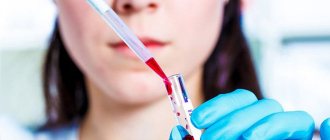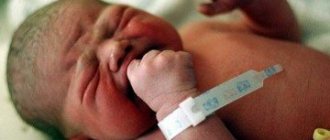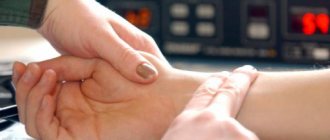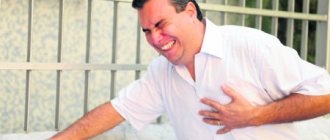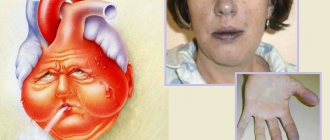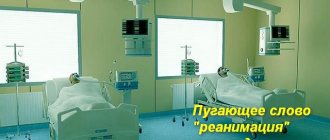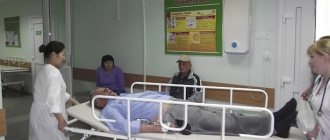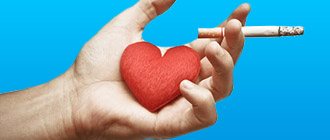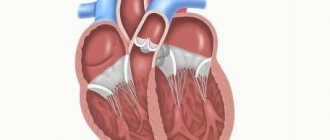Signs of clinical death
Clinical death is a reversible stage of dying, in which there are no signs of life, but irreparable changes in the structures of the brain have not yet occurred. The main manifestations of clinical death include:
- Depression of consciousness to the point of coma, lack of response to stimuli;
- Inability to inhale and exhale independently;
- Absence of pulse in the area of large arteries.
Additional signs include:
- dilated pupils;
- their lack of reaction to light;
- pale or bluish tint to the skin.
Important!
The fatal condition is considered completely reversible within the first 5-6 minutes. Then the death of brain cells occurs due to oxygen starvation and exposure to toxins - products of tissue breakdown.
If clinical death occurred due to hypoxia or poisoning with neurotoxic poisons, then the period of reversible changes in the brain is significantly reduced.
If death occurs due to exposure to low temperatures, then a full restoration of vital activity is possible even 15-20 minutes after cardiac arrest.
When to perform and stop CPR
The indication for cardiac and pulmonary resuscitation is any case of sudden clinical death. To assess the condition of the victim, you need to conduct a quick examination using the following algorithm of actions:
- Find out if the person is conscious. Talk to him loudly, shake him, and squeeze your fingertip tightly. If there is no reaction to these actions, then consciousness is absent.
- Determine the presence of breathing by movements of the ribs and anterior abdominal wall. If in doubt, lean over the patient's face to feel the movement of air on your cheek or hear the sound of inhalation or exhalation. We wrote in more detail about emergency care for respiratory arrest here.
- Assess for the presence of pulsation in the carotid arteries. To do this, place the pads of 2-3 fingers in the groove between the Adam's apple and the sternocleidomastoid muscle and wait for at least 5 seconds. The standard determination of the pulse on the radial artery may not be indicative, since it is not felt in this zone with low blood pressure. First aid for cardiac arrest is described in this article.
- To make sure that the victim is clinically dead, lift his upper eyelids. An unfavorable sign is wide pupils that do not contract when light hits them.
In the described cases, it is necessary to begin resuscitation measures.
Attention!
It is very important to carry out the inspection at an accelerated pace. It should not take more than 15 seconds, since the person should be brought back to life as quickly as possible.
To speed up the process, it is advisable to perform several manipulations simultaneously. For example, listen to breathing and palpate the carotid artery, try to “shout out” to the patient and look at the condition of his pupils.
When not to perform resuscitation
In addition to indications, there are also contraindications to cardiopulmonary resuscitation. These include:
- Death resulting from a long-term, debilitating disease (liver cirrhosis, end-stage renal failure, severe pathologies of the heart and lungs);
- Death due to incurable diseases (malignant neoplasms, amyotrophic lateral sclerosis, congenital malformations, etc.);
- Damage incompatible with life;
- Signs of biological death;
- Fractures of several ribs and sternum with massive bleeding from the chest are a contraindication for performing chest compressions.
Biological death is determined by the following manifestations:
- Cloudiness of the eyes, the appearance of a whitish coating on the pupils and iris due to drying out of the cornea.
- Deformation of the pupil when lateral pressure is applied to the eyeball - it becomes slit-like.
- The formation of purple cadaveric spots in the underlying parts of the body, which is associated with the redistribution of blood in the vascular bed.
- The body is cold to the touch.
- The muscles of the body are hard, it is difficult to straighten the bent limbs - rigor mortis has set in.
Indirect cardiac massage: technique
To perform an indirect cardiac massage, you need to place one hand (palm down) on 1/3 of the lower part of the sternum. The main center of pressure should be on the metacarpus. Place your other palm on top. The main condition is that both hands must be kept straight, then the pressure will be rhythmic with equal force. The optimal force is considered to be when the sternum drops 3–4 cm during chest compressions.
| Age | Hand | Pressing point | Depth per click | Frequency | Inhalation/pressure ratio |
| Up to 1 year | 2 fingers | 1 finger below the nipple line | 1.5-2 cm | 120 | 1/5 |
| 1-8 years | 1 hand | 2 fingers from the sternum | 3-4 cm | 100-120 | 1/5 |
| Adult | 2 hands | 2 fingers from the sternum | 5-6 cm | 60-70 | 1/5 - 2 rescuers 2/15 - 1 rescuer |
What happens in the body during resuscitation? When exposed to the chest, the chambers of the heart are compressed, while the interchamber valves open, and blood penetrates from the atria into the ventricles. The mechanical effect on the heart muscles helps push blood into the vessels, which prevents the blood flow from stopping completely. If the actions are synchronous, then the heart’s own electrical impulse is activated, thanks to which the heart “starts” and blood flow is restored.
Preparatory actions
Before starting resuscitation, you need to determine the presence of indications and contraindications, as well as quickly carry out preparatory measures:
- Make sure that you and the patient are not in danger. If necessary, the victim is removed from the area exposed to toxic volatile compounds, high or low temperatures, from a building that may collapse, etc.
- Call for help, ask others to call an ambulance.
- Find out whether the victim’s airways are passable - open the mouth, determine the presence of vomit, food, foreign bodies, or a sunken tongue. Remove them mechanically with your fingers wrapped in a napkin.
- Assess for severe injuries. If a spinal fracture is suspected, the patient must be moved with extreme caution. If the cervical spine is damaged, then you cannot tilt your head back to perform artificial respiration; it is left in a straight position; it is only permissible to place a low cushion under the shoulders. In case of massive damage to the chest, do not perform an indirect cardiac massage, which will be ineffective and will provoke additional trauma to the internal organs. In case of injuries to the lips or jaws, traditional mouth-to-mouth artificial respiration is replaced by the mouth-to-nose technique.
- Place the patient on a hard, flat surface and tilt his head back, unless this is contraindicated. Move the lower jaw forward. To do this, place your thumbs on the patient’s forehead, and with the rest, grab the lower jaw from behind, under the ears, and pull it forward.
BASICS OF CARDIOPULMONARY RESUSCITATION
Resuscitation is a set of practical measures aimed at restoring the vital functions of the body.
If the victim has no consciousness, visible breathing or heartbeat, the entire complex of resuscitation measures (cardiopulmonary resuscitation) is immediately carried out at the scene of the incident.
Cardiopulmonary resuscitation is not performed:
in case of injuries or injuries incompatible with life;
with obvious signs of biological death;
for incurable chronic diseases (for example, malignant tumors);
Signs of biological death:
An early sign of biological death, appearing 10-15 minutes after the death of the brain, is the “cat’s pupil” (Beloglazov’s symptom), detected by slight compression of the eyeball, from which the pupil changes shape - it lengthens, becoming similar to a cat’s (slide 4.5. 31).
Much later (after 2-4 hours) obvious signs of biological death are revealed - cadaveric spots and rigor mortis.
Biological death can be declared based on the cessation of cardiac activity and breathing lasting more than 30 minutes.
Stages of basic cardiopulmonary resuscitation
A - (air way) ensuring patency of the victim’s upper respiratory tract;
B — (breathe) performing artificial pulmonary ventilation (ALV);
C - (circulation) diagnosis of circulatory arrest, maintenance of artificial circulation by external cardiac massage.
A . Patency of the upper respiratory tract is ensured by a triple dose of Safar, which includes the following elements:
1. Throwing back the victim’s head.
2. Advancement of the lower jaw anteriorly.
3. Opening the mouth.
During the first two techniques, tissue tension occurs between the lower jaw and larynx, while the root of the tongue moves away from the back wall of the pharynx and thus the patency of the upper respiratory tract is restored.
Triple technique:
1. The victim should be laid on his back and unbuttoned clothing that impedes breathing and blood circulation in the chest area.
2. You need to tilt the victim’s head back by placing one hand under his neck and carefully lifting it, and placing the other on his forehead and pressing on it until he tilts back to maximum - this usually leads to the victim’s mouth opening (slide 4.5.32).
3. If the victim’s mouth is closed and his chin droops (the neck muscles are relaxed), it is necessary to push the lower jaw forward, moving the hand from under the victim’s neck to his chin; At the same time, keep the victim’s mouth slightly open (slide 4.5.33).
In unconscious victims, the lower jaw can be moved forward more effectively by inserting the thumb into the mouth.
These actions can be performed alternately.
In victims with suspected cervical spine injury, maximum tilting of the head can aggravate damage to the spinal cord (flexion and rotation of the head are absolutely contraindicated); advancement of the lower jaw with moderate tilting of the head is considered the best method of restoring airway patency.
4. Examine the oral cavity for the presence of foreign matter (vomit, food debris, mucus, etc.). If necessary, quickly empty the mouth with a finger wrapped in a scarf or gauze.
B. After performing the triple Safar maneuver (it takes a few seconds to complete), it is necessary to take 2-3 test breaths into the victim’s lungs.
1. If the chest does not inflate, a foreign body may be suspected in the upper respiratory tract. In this case, the foreign body should be quickly removed.
One of the effective techniques for removing a foreign body (for example, a piece of food) from the respiratory tract into the pharynx and/or larynx is the Heimlich maneuver, designed to instantly increase intrapulmonary pressure, with the help of which the foreign body can be pushed out of the respiratory tract as shown on slide 4.5.34.
2. If the victim’s chest rises, artificial pulmonary ventilation (ALV) should be started.
Artificial pulmonary (ALV) is part of the complex of resuscitation measures, and is also used in cases of respiratory arrest in the presence of a heartbeat.
Ventilation can be performed on either side of the injured person.
Mouth-to-mouth ventilation technique:
1) with the head thrown back (if necessary, the lower jaw pushed forward), tightly squeeze the wings of the nose with your fingers;
2).
3) after straightening the chest, remove the lips from the victim’s mouth and stop squeezing the wings of the nose to ensure the independent (passive) release of air from the lungs.
The duration of inhalation (exhalation of the rescuer) and passive exhalation of the victim is 5 seconds (12 breathing movements in 1 minute). The volume of air required for inhalation by an adult is 0.8-1.2 liters.
The intervals between breaths and the depth of each breath should be the same.
The mouth-to-nose ventilation technique is used when it is impossible to carry out the mouth-to-mouth method (injury to the tongue, jaw and lips).
The position of the victim, the frequency and depth of breaths, and the implementation of additional measures are the same as with artificial respiration using the mouth-to-mouth method. The victim's mouth should be tightly closed. Insufflation is carried out into the nose.
Mouth-device-mouth ventilation technique
The mouth-device-mouth artificial respiration device is an S-shaped tube.
Insertion of an S-shaped tube. Throw back your head, open your mouth and insert the tube in the direction opposite to the curvature of the tongue and upper palate, advance the tube to the middle of the tongue, rotate the tube 180° and advance to the root of the tongue.
Inhalation. Take a deep breath, grasp the end of the tube protruding from the mouth and forcefully blow air into it, ensuring a tight seal between the victim’s mouth and the tube.
After completing the insufflation, give the victim the opportunity to exhale passively.
The position of the victim, the frequency and depth of breaths are the same as during artificial ventilation of the lungs using the mouth-to-mouth method.
Artificial ventilation of the lungs is accompanied by simultaneous visual monitoring of the movements of the victim’s chest.
C. Indirect cardiac massage is performed in all cases of cessation of cardiac activity and, as a rule, in combination with artificial ventilation (cardiopulmonary resuscitation). In some cases, breathing can be maintained (electrical trauma), then only indirect cardiac massage is performed.
Signs of cardiac arrest:
sharp blueness or pallor of the skin;
the pulse in the carotid artery is not detected;
consciousness is absent.
Technique for performing indirect (closed) heart massage for an adult:
1) quickly lay the victim on his back on a hard surface (floor, ground);
2) kneel on the side of the victim;
3) place the base of the palm of one hand on the victim’s sternum, stepping back 2 fingers from the edge of the xiphoid process, and place the palm of the other hand on top of it (slide 4.5.35)
4) with an energetic jerk-like movement of straightened arms, press on the sternum to a depth of 4-5 cm, using your own body weight;
5) after each pressure, give the chest the opportunity to expand on its own, without removing your hands from the chest.
Compression of the heart and lungs between the sternum and spine is accompanied by the expulsion of blood from the heart, lungs and large vessels. In this case, the blood flow in the carotid arteries is only 30% of normal, which is not enough to restore consciousness, but can maintain the minimum exchange that ensures the viability of the brain.
The cessation of pressure on the sternum leads to the fact that the chest, due to its elasticity, expands, the heart and vessels of the lungs passively fill with blood
The effectiveness of pressure on the sternum is assessed by the pulse wave, which is determined on the carotid artery at the moment of the massage push.
The frequency with which indirect cardiac massage should be performed is 80-100 movements per minute!
Monitoring the effectiveness of cardiopulmonary resuscitation (CPR) is carried out after the first 4 cycles of resuscitation measures (inhalation-massage) and every 1 - 2 minutes during a short-term (no more than 5 seconds) cessation of cardiopulmonary resuscitation. It is carried out by the person conducting artificial ventilation of the lungs (i.e., located at the victim’s head).
A combination of techniques for restoring breathing and cardiac activity
If two people provide assistance, then one of them does indirect cardiac massage, and the other does artificial respiration. In this case, the ratio of blowing into the mouth or nose of the victim and indirect heart massage is 1:5.
If one person provides assistance, then the sequence of manipulations and their regime change - every 2 breaths of air into the victim’s lungs, 15 chest compressions (2:15) .
Indicators of effective CPR
change in skin color (decreased pallor, cyanosis);
the appearance of an independent pulse in the carotid arteries, not associated with compression on the sternum;
constriction of the pupils;
restoration of spontaneous breathing.
If during CPR a spontaneous pulse appears in the carotid arteries, but there is no spontaneous breathing, only mechanical ventilation should be continued.
After successful CPR, the victim must be given a stable position on his side to prevent the tongue from retracting and vomit from entering the respiratory tract, as shown in slide 4.5.36.
Resuscitation measures are stopped in the following cases:
when a pulse appears in the carotid arteries and spontaneous breathing in the victim;
if within 30 minutes of their implementation the above signs of CPR effectiveness do not appear.
Stages of resuscitation
There are 3 stages of cardiopulmonary resuscitation:
- Basic life support - cardiac massage through the chest wall, artificial respiration. These are measures aimed at the primary fight against hypoxia.
- Further maintenance of vital functions - use of a defibrillator, mechanical ventilation, administration of emergency medications (adrenaline, dopamine), ECG monitoring. The listed manipulations are carried out by resuscitators.
- Long-term life support is treatment in the intensive care unit aimed at eliminating the causes of clinical death and eliminating its consequences.
Note!
The first stage is the only one available to people without medical education.
Hardware CPR
Resuscitation measures can be carried out using special devices. They are used by emergency physicians and resuscitators in hospitals.
Devices used in intensive care:
- Mechanical ventilation device. It is used only in hospitals. The patient's trachea is intubated (a special tube is inserted into the trachea). A device is connected to the tube that pumps air into the lungs;
- A defibrillator is a device that applies an electric current to the heart muscle. They can be portable (used by ambulance teams) and stationary (located in the intensive care unit). Their operating principle is identical. Electrodes are placed on the patient's chest and a shock is delivered.
Currently, an AED (automated external defibrillator) can be used. It can be used by people without medical education. This device is equipped with voice instructions.
Indicators of effective CPR
While performing CPR, you need to continuously monitor the patient’s condition: monitor whether he has begun to breathe on his own, or whether pulsation of the arteries has appeared. Criteria for the effectiveness of resuscitation measures:
- The appearance of a pulse in the carotid arteries, and then in the radial and other great vessels;
- The appearance of independent respiratory movements;
- Constriction of pupils to light;
- Restoration of the physiological color of the skin, lips;
- Increase in systolic (upper) blood pressure to at least 60 mm Hg. Art.
As a rule, if the resumption of vital activity does not occur within 10 minutes, then full recovery cannot be expected. During this time, under hypoxic conditions, some of the nerve cells die, which leads to an irreversible loss of their functions.
Reference!
The cerebral cortex is the evolutionarily “youngest” part of the brain, so it begins to die first during hypoxia. Consequently, with prolonged CPR, higher brain functions - thinking, memory, speech - will be the first to suffer.

